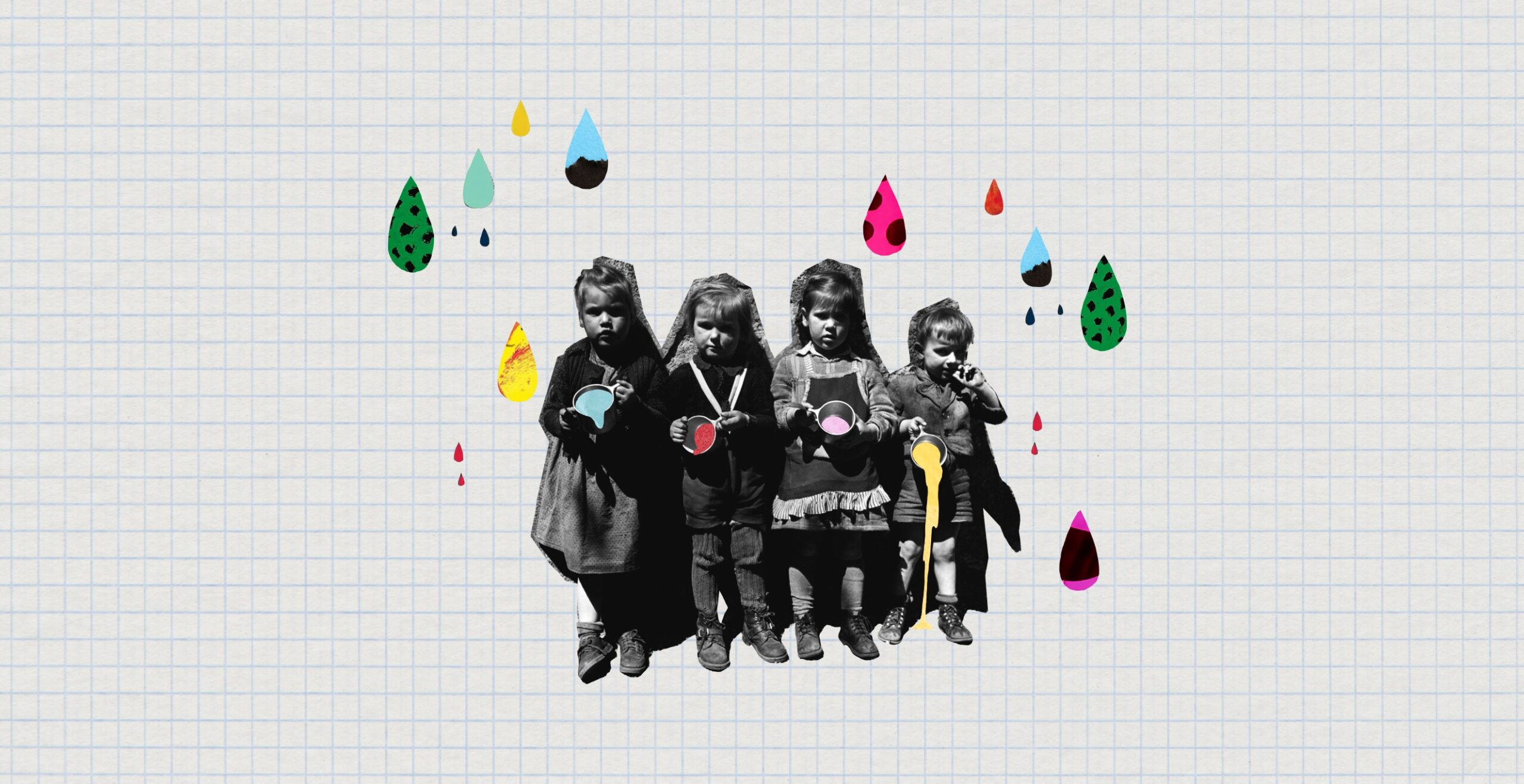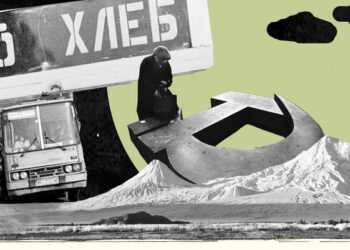
Illustration by Armine Shahbazyan.
A lot has been written about the aftermath of the 2020 Artsakh War, but less attention has been devoted to how the war affected children. What impact has it had on children living in Armenia and Artsakh? How does a child deal with war trauma and process the barrage of negative news and feelings, like fear, fury, despair, shock or helplessness? Art therapy is a powerful therapeutic tool that can provide insights into how children are coping with such negative experiences. It also helps children express their feelings and build up self-confidence. Armine Arakelyan, one of the leading art therapy specialists in Armenia, says children are in constant need of new impressions and creative approaches in the classroom and beyond, even more so after a shocking and devastating event like war. Arakelyan has over 30 years of experience, including working with children with special needs and autistic children. Trained as an artist, art tutor and art therapist, she has worked with various organizations like World Vision Armenia, Armenian Caritas, COAF, the Henrik Igityan National Centre for Aesthetics and others. In 2011, Arakelyan co-founded the Art Therapy Centre in Yerevan. In the summer and autumn of 2021, she joined the Tackling Educational Disadvantage in Rural Armenia project as an art therapy instructor.
The education project is the first organized by the Oxford Armenia Foundation (OAF), a newly-established charity. The devastating 2020 Artsakh War served as an impetus for the creation of numerous Armenia-centered volunteer and activist groups and organizations. OAF focuses on education issues in Armenia’s rural areas. The foundation is based in Oxford, England, and most of its founding members are students or alumni from the University of Oxford. September 2021 marked the completion of the first educational program by OAF in partnership with Armenian Caritas, a Gyumri-based NGO with a proven track record of successfully implementing projects with a focus on disability, inclusion and children with special needs. The Tackling Educational Disadvantage in Rural Armenia project provided over 100 disadvantaged children from the Bayandur and Yerazgavors border communities of Shirak region with free dancing, painting and art therapy sessions, paired with a series of educational trips to cultural sites in Shirak region.
The project sought to address several problems, including social isolation of the children living in the target communities, a lack of educational and developmental opportunities for children and teenagers in the area, and limited or no access to after-school clubs and other educational facilities, most of which are restricted to urban areas. For context, Yerazgavors and Bayandur are border villages located less than one kilometer from the Armenia-Turkey frontier, next to the Akhuryan Reservoir. Moreover, given the devastating psychological aftermath of the recent war, the program employed art therapy as a therapeutic tool in order to help project beneficiaries overcome negative consequences of the recent war with Azerbaijan and work through their emotions and trauma in a constructive and artistic manner. This is ever more relevant as many young men living in Shirak join the armed forces as contract soldiers because of widespread unemployment and economic hardship; the region is known to be the poorest and most economically-deprived one in Armenia. The situation is aggravated by lingering consequences of the 1988 earthquake, as the region still bears visible traces and signs of it. These factors fed into OAF’s decision to choose Shirak as the target area for the project.
During the project, each art therapy session was devoted to a new theme. Some of them were quite concrete, while others more abstract, e.g. home, self, peace, beauty. The children were asked to think about these topics and try to express them by painting or drawing on a blank sheet of paper. What emerged was telling.
Signs of War
Certain traces of war, like menace and a feeling of loss, are evident in the artwork of the children. According to Arakelyan, there are flags and soldiers in their paintings, including wounded or even dead soldiers. Some of the children preferred to paint themselves in the past rather than present or future, which might be a sign of traumatic past experiences. Concentrating on the past stops a child from grasping the opportunities for development and progress. A number of works also contained reflections on life and death topics. On a positive note, most children, including girls, were eager to participate in the protection of the homeland, regarding it an important and admirable task.
Low Self-Esteem and Lack of Trust Toward the World
One of the tasks at the art therapy sessions was to tell a story through a book of the child’s own illustrations, and later present it to the group. Initially, the majority of the children said they had no story to tell and refused to complete the task, additionally justifying their refusal by saying that they are bad at drawing and painting. At a later stage, after the initial barrier was overcome, many of them wanted to erase what they had painted, to burn or hide it. Arakelyan explained to the children that nothing is erased at art therapy sessions. Instead, it’s important to accept our own works and try to transform them if one is not happy with the result. Once the books of illustrations were completed, most children were reluctant to present their stories, stating that they were worth nothing. Arakelyan encouraged the children to present the stories, assuring them that there is no place for criticism and comparisons or marks in art therapy. It is worth noting that some of the stories had a negative outcome. Such examples make implications about the children’s low self-esteem and lack of self-confidence. Armine notes that many works signalled a lack of trust on the part of the children toward themselves and the world. Another reiterated idea is that, in the children’s opinion, what they made had no value. They do not believe in their own skills and strengths. While the children are positive about themselves, this positive image does not correspond to how they think others see them.
Negative Expectations From a Classroom Format
In Yerazgavors, the local school premises served as the venue for the art therapy sessions, as the school administration kindly granted project implementers access to classrooms. For some of the children, particularly boys, this turned into a deterring and demotivating factor. One reason for this could be that school is associated with strictness, discipline and being put under pressure. Evidently, the children were afraid of failure and were discouraged as a result. Arakleyan notes that it is extremely important to have a separate space for arts, preferably a studio, where children can be fully immersed in the creative process.
Simplistic Imagery and Poor Imagination
One of the goals of art therapy is to boost children’s imagination and creativity, and help them create images of their own. According to Arakelyan, many works by the children contained simplistic and poor imagery. She connects this to the fact that the children spend most of their free time watching visual materials on the Internet. For many, this is the only available pastime, making it inevitable that ready-made images and characters from the virtual realm are replicated in the children’s works.
Boosting a Child’s Creative Development
As mentioned earlier, children and teenagers constantly need to be exposed to new ideas, impressions and emotions. These stimulate their creativity and art skills. It is important that parents, teachers and local authorities provide children with the necessary conditions for practicing art or art therapy. The best venues for having art classes are undoubtedly art studios and workshops. If these are unavailable, children’s libraries and museums can serve as an acceptable alternative. The classroom isn’t always the best choice.
Thanks to art therapy and Arakelyan’s contribution to the project, it has become possible to unlock the children’s creative potential and start building up their art skills. Art therapy helped the children process and express their feelings and experiences, while boosting their self-confidence and trust toward their own strength, talent and worth. Some of the children came up with an idea to start a theater group, while a boy from Bayandur even decided to give up karate for the duration of the project in order to join painting classes with Vachagan Azatyan, the program’s inspirational painting instructor. This gives hope that the value and prestige of doing arts will be restored even in Armenia’s most remote corners.
The author is a member of the Oxford Armenia Foundation.
New on EVN Report
From Sochi to Brussels: Challenges and Opportunities
As Armenia works to rebuild its positions following the 2020 Artsakh War, it must assess the challenges, threats and risks of the security environment and clarify a position that reflects state and national interests.
Read moreNow Is the Time to Follow Aram Manoukian’s Path
Are Armenians doomed to endure the contemptuous kleptocracy of the “old” and the cynical defeatism of the “new”? Gaidz Minassian proposes an alternate vision, one that was conceived of by Aram Manoukian over a century ago.
Read moreThe Endless Geopolitical Struggle
Western attempts to infiltrate into the sphere of Russian influence have meant to weaken Russia and maintain constant tension. Could this result in larger clashes with more unpredictable consequences, this time between large geopolitical players?
Read moreHow to Avoid a Deadlock or the Use of Force During the Delimitation of the Armenian-Azerbaijani Border?
In light of Azerbaijan’s aggressive military operations, the international community’s response and the formation of a format for the delimitation and demarcation process, Sossi Tatikyan offers comprehensive suggestions on potential formats and phases.
Read moreA National Hiking Trail
The opening of the Armenian section of the Transcaucasian Trail means hikers can now walk the length of Armenia along a specially-constructed footpath that connects the Iranian and Georgian borders, taking in some of Armenia’s most spectacular landscapes and cultural sites on the way.
Read more





